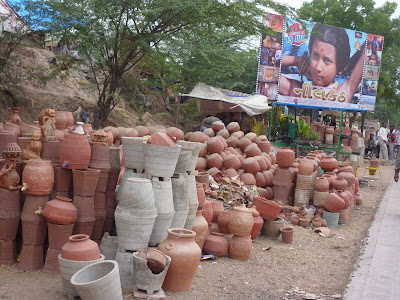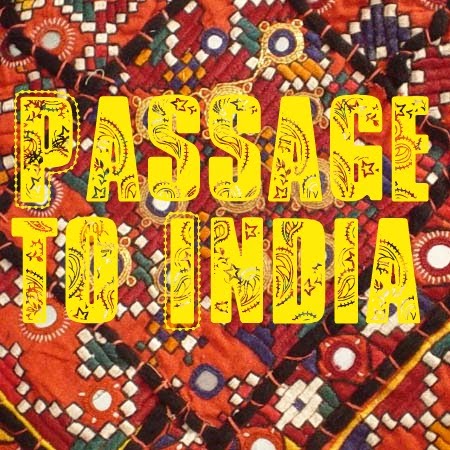Pottery
In Hindu mythology, Bhrama, the Creator of the Universe, made a clay model of a human into which he breathed life. For this reason, the Hindu potter is known as Prajapati, meaning the creator of humanity. The Kumbhar (potters’) communities of Kachchh and throughout India have a strong religious connection with their work. They believe that the god Shiv has blessed them with protective fire and a consistent work that will always be enough to sustain their families. Pottery is particularly meaningful to the craftspeople because its creation represents the culmination of all five of the Hindu elements: fire, water, earth, air, and akasha (space).
Crafting earth
Kachchhi potters must have an intimate understanding of the environment
for their craft to thrive.
To collect quality clay, potters in the Banni region travel
far into the grassland seeking dense clusters of vegetation. They know that where
there are grasses there will be a subterranean water source, and therefore a
smooth, quality clay pocket perfect for ceramics. The potters of Tuna near the
sea wade directly into the water to collect clay from below their feet. Here
the clay is salty and porous, able to hold water and keep it cool.
To obtain the black, red and white clays used both for
building and decorating their pots, artisans collect white china clay and
mineral-rich red and black clays from specific pockets in the area. The geographic
knowledge and ability to assess quality of these sources is passed down from
generation to generation. When the
monsoon season begins and clay becomes less accessible, the potters give up
their craft temporarily, focusing on seasonal agricultural work.
In its form and practice, the Kachchh pottery craft represents
a deep-rooted understanding of the environment as well as representing a model
of local, natural, and sustainable craft practice.
The Process
 |
| Firing the pots in a big pit. |
 |
| Sara-bai's adorable granddaughters on their way to Arabic lessons after school. (Unrelated, but I had to include this photo) |
 |
| White, black and red slips are used for decoration. The brushes are all pieces of wood that are frayed at one end. This is one reason Sara-bai's detailing is so amazing. |
 |
| Sara-bai paints delicate lines using a thick wooden brush. |
 |
| I tried painting a scrap with the wooden brushes. SO HARD. Sara-bai did like my bird motif, though. |
 |
| Some finished products. |
 |
| Instead of keeping water in the fridge (which many people don't have), people in Kachchh (and around India) keep water in a pot like this. The porousness of the clay keeps the water cool. |
 |
| Vendors in Bhuj sell pots on the side of the road. |
Terracotta and the stages of life
In Kachchh, as in other parts of India, pottery plays an
important ritualistic role in the cycle of life. Communities use dozens of
forms of terracotta to correspond with the different stages of life: clay bowls
holding oils, water, leaves, and coconut are used as part of the sixth-day chahti
ceremony that marks the birth of a child; small lamps are used daily for ritual
pujas; terracotta of many sizes
and shapes are used as part of the marriage ceremony to hold up the wedding
canopy and to contain smaller ritual items such as water, rice, oil, ghee, and khum
khum (red paste); the clay is shaped
into animals as children’s toys; into lamps for festivals; and into special
bowls for use in the death ceremony.
Hindu tradition teaches that porous earthenware
absorbs dirt and negative energy. Rules
of ritual pollution therefore require people to discard and replace earthenware
during festivals and significant occasions such as births, marriages, and
deaths. As a result of this belief,
potters have historically enjoyed a stable local market for their craft.
An Ancient Lineage
Modern Kachchhi pottery traces its roots back thousands of
years to the time of the Indus Valley Civilization. One of the world’s earliest urban
civilizations, the Indus Valley Civilization spread across the western region
of South Asia (in what are now Pakistan, Eastern Afghanistan, and Northwestern
India including Kachchh) from 3300-1300 BCE. The civilization is noted for its architectural
accomplishments such as building cities of brick, roadside drainage systems,
and multistoried houses, along with a number of handicrafts that include
pottery.
Today, the potters of Kachchh continue to practice their
craft in much the same way as their geographic ancestors. Collecting clay from
pockets in the region, building up pots by hand or on the wheel, and painting
their products with motifs passed down through the generations, many modern terracotta
pieces reveal the influence of the ancient pottery of the region. At the same
time, today’s potters take artistic liberties in order to market to new
audiences, creating a variety of products for both the local market and beyond.
 |
| Fragment of pottery from Indus Valley Civilization |
Painted Pottery Around India
Pottery is one of the most universal of all crafts –
terracotta is found on every continent and the craft has been practiced for
thousands of years. In India alone there are dozens of pottery styles, forming
objects that transgress barriers of caste and religion and are used at every
stage of life.
Despite the ubiquitous nature of pottery, only a few regions
within India boast the kinds of intricate painting techniques found in Kachchh.
In Rajastan, bold blocks of white and red highlight the complicated black designs
painted on top. Potters in Himachal Pradesh paint white lines directly onto red
surfaces, which become discolored as part of the smoke fire process that
defines the region’s work.
In Kachchh, potters paint delicate black and white designs
over their red-coated terracotta or red and black designs on white coated
pieces. Many of the motifs are similar
to those discovered at Indus Valley Civilization sites in the region such as
Dolevida and Lothal, suggesting a remarkable continuity in design passed down
from generation to generation. In addition,
the similarities in design among pottery in Northern India and Eastern Pakistan
suggest the history of trade and migration that have historically linked these
regions.







No comments:
Post a Comment